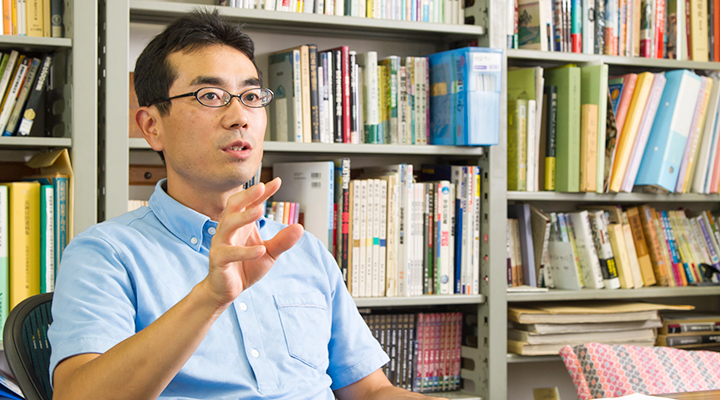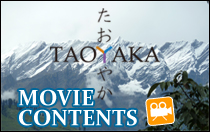
INTERVIEW
Research on clarifying the relation between nature and
human activity through geomorphological study
Learning method to
understand origin of landform
in disadvantaged areas
Cultural Creation Course
Graduate School of Humanities and Social Sciences
Assoc. Prof.Yasuhiro Kumahara
Research on clarifying the relation between nature and
human activity through geomorphological study
Specializing in “geomorphology”: Research on active faults and relations between historical highways and landform

There are two large pillars that support Associate Professor Kumahara: “Active faults” and “historical highways/irrigation patterns.” He introduced an outline of his studies.
“People tend to imagine seismological study using complicated numerical formulas when hearing ‘active faults,’ but I start studying from landform and geological layers without using formulas.”
The associate professor says that because large earthquakes with shallow depth occur from active fault movement, studying the gaps and ages between geological layers will determine how frequently earthquakes occurred in the past.

“In other words, future earthquakes can be estimated through fieldwork. I’ve been continuing this research since graduate school because such aspects fascinate me,” he says.
Associate Professor Kumahara plans to go on a field survey in the fall following the disastrous earthquake that struck Nepal in April 2015. Active faults maps are currently being prepared for Nepal and Bhutan.
“Providing such active faults map in developing countries will help in reducing risks caused by earthquakes, such as not building important facilities such as hospital or school on an active fault.”

Associate Professor Kumahara also studies historical highway to investigate the relationship between historical paths and landform.
“I’m particularly researching how Nakasendo, the route that connected Tokyo and Kyoto in the Edo period, was created upon going through what kinds of landform. Routes should have been created based on landform because there were no technologies available to build tunnels and bridges back then. The research will estimate the intentions of the route creators through landform.”
How to understand landform: Learning from both deciphering of primary sources and on-site surveying

Associate Professor Kumahara is in charge of the “Comparative Physical Geography of Mountainous Regions” class. The class introduces the landform of Nakasendo in an easy-to-understand manner, and linked to the research mentioned previously on the highway.
According to the associate professor, Nakasendo runs through the central parts of Japan, with almost all types of landforms observed in Japan included in the road.
“There’s so many types of good example of landforms that anyone can understand, including mountains, volcanoes, lakes and plains,” he exclaims.
The class first covers what types of landform were visible when people walked from Kyoto to Edo (present Tokyo), and how people used landform to live.
The class’s objective is to “learn how to understand landform.” Students conduct fieldwork after lectures at the Saijo Basin near the campus. The Azumako Falls waterfall shown in the picture is also located in the area.
“Students need to thoroughly study how to understand landform by using maps and aerial photographs indoors prior to conducting fieldwork. You won’t be able to understand what is going on if you go without studying, but will know how the landform is if you see maps and aerial photography beforehand. You’ll know how to understand landform.”
Students can progress to know the correlation between topography and human activity once they can identify the origin of landform by themselves. This class provides fundamental knowledge and technique needed to draw out a diverse array of information.
Anticipating that attitudes of observing actual objects will be advantageous in the program

Associate Professor Kumahara has been involved in the Taoyaka Program since immediately after joining Hiroshima University, and is currently a public relations committee member. Although he doesn’t have students directly teach as of now, he shared his thoughts on the Taoyaka Program.
“I believe that there may be a way to utilize know-how on understand landform in disadvantaged areas. In such regions, for example, ways to acquire water become important issues, and most likely cannot be resolved without considering landform. In this sense, the lecture will help greatly on-site.”
He also contributed a message for students looking forward to participate in the program.
“The program requires physical strength for field studies, but diligently studying for preparation is more important. The Taoyaka program requires the attitude of ‘patiently observing.’ I think ‘patience’ is needed in various situations in the program. Some students focus more on using GIS and do not have good impressions for fieldwork, but retrieving original data actually has a lot of meaning to it. You can contribute to disadvantaged areas for the first time by acquiring something on your own. I’m looking forward to have students with this type of mindset.”

![]()
Yasuhiro Kumahara Associate Professor
Program in Educational Design for Teacher Educators, Division of Educational Sciences, Graduate School of Humanities and Social Sciences
April 1, 2020 – Associate Professor, Hiroshima University Graduate School of Humanities and Social Sciences
October 1, 2013 – March 31, 2020 Associate Professor, Hiroshima University Graduate School of Education
April 1, 2010 – September 30, 2013 Associate Professor, Faculty of Education, Gunma University
November 1, 2007 – March 31, 2010 Lecturer, Faculty of Education, Gunma University
April 1, 2007 – October 31, 2007 Assistant Professor, Hiroshima University Museum
April 1, 2006 – March 31, 2007 Research Associate, Hiroshima University Museum
April 1, 2004 – March 31, 2006 Research Associate, Research Center for Regional Geography, Hiroshima University
April 1, 2003 – March 31, 2004 Teaching Assistant, Graduate School of Letters, Hiroshima University
April 1, 2001 – March 31, 2003 Research Fellowships for Young Scientists, Japan Society for the Promotion of Science





